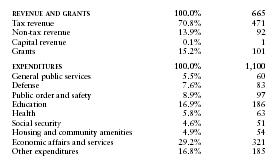Nepal - Public finance
Nepal's fiscal year ends on July 15. The continued and increasingly violent Maoist insurgency, entering its seventh year in February 2003, has had crippling impacts on Nepal's public finances, interfering with tax collections and disrupting production while at the same time requiring increased public spending on security and to repair damaged infrastructure. Most fundamentally, the insurgency hampers the government's efforts to address the poverty and other social problems fueling the rebellion. The perception of widespread corruption aggravates the present difficulties as does the global economic slowdown.
Historically, most deficits on capital account have been financed by foreign grants, while domestic revenues have been sufficient to cover current expenditures. During the first three years of Nepal's Ninth Five Year Plan (FY 1997/98 to FY 2001/02) domestic revenues were sufficient to cover current expenditures, although with a decreasing margin, and capital expenditures were met with foreign grants and only small amounts of domestic borrowing. Measured as a percent of GDP, according to IMF estimates total revenues for FY 1997/8 to FY 1999/00 were 10.5%, 10.2%, and 10.7%, respectively, while corresponding current expenditures were 9.2%, 9.3% and 9.6% of GDP, respectively. The overall deficit after grants remained above 3% of GDP, at 4.5%, 3.9%, and 3.5%, respectively, but domestic financing remained low, at 0.6%, 1.4% and 0.9% of GDP, respectively. However, in FY 2000/01, the gap between revenue, at 11.4% of GDP, and current expenditures, at 11.2% of GDP, narrowed and domestic financing of the budget deficit rose to 2.7% of GDP. Projections for FY 2001/02 by the IMF estimate that, for the first time during the Ninth planning period, revenues, at 11.4% of GDP, will not cover current expenditures, at 12.3% of GDP. Even with capital expenditures reduced to 5% of GDP, down from an average of 6.5% of GDP for the previous four years, and foreign aid increased to 2% of GDP, up from a four year average of about 1.6% of GDP, domestic financing is expected to be at 2.6% of GDP.
Macroeconomic policy in FY 2001/02 was focused on increasing revenue collection, maintaining strict expenditure priorities, and containing domestic borrowing. A voluntary disclosure of income scheme (VDIS) plus other special revenue measures probably contributed to raising domestic revenues collected to 11.4% of GDP in FY 2000/01 and FY 2001/02, up from an average of less than 10.5% for the three previous fiscal years, but the relative rise in expenditures— 1.5% of GDP— has outpaced the 0.9% rise in the revenue effort. Domestic public debt is estimated to have risen from about 14% of GDP in FY 1998/99 to about 18% of GDP in FY 2001/02, raising concerns that with increased domestic financing, in an environment in which bank deposit rates are stagnant, banks will have to draw on Nepal's scarce hard currency reserves. For FY 2000/01 the CIA estimated Nepal's external debt at $2.55 bil. By IMF estimates, total public debt in FY 2000/01 came to 49.9% of GDP, somewhat below the average for the previous five years of 52.2% of GDP. The US Central Intelligence Agency (CIA) estimates that in 1999/2000 Nepal's central government took in revenues of approximately $665 million and had expenditures of $1.1 billion. Overall, the government registered a deficit of approximately $435 million. External debt totaled $2.55 billion.
The following table shows an itemized breakdown of government revenues and expenditures. The percentages were calculated from data reported by the International Monetary Fund. The dollar amounts (millions) are based on the CIA estimates provided above.

| REVENUE AND GRANTS | 100.0% | 665 |
| Tax revenue | 70.8% | 471 |
| Non-tax revenue | 13.9% | 92 |
| Capital revenue | 0.1% | 1 |
| Grants | 15.2% | 101 |
| EXPENDITURES | 100.0% | 1,100 |
| General public services | 5.5% | 60 |
| Defense | 7.6% | 83 |
| Public order and safety | 8.9% | 97 |
| Education | 16.9% | 186 |
| Health | 5.8% | 63 |
| Social security | 4.6% | 51 |
| Housing and community amenities | 4.9% | 54 |
| Economic affairs and services | 29.2% | 321 |
| Other expenditures | 16.8% | 185 |
Comment about this article, ask questions, or add new information about this topic: